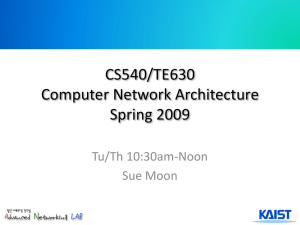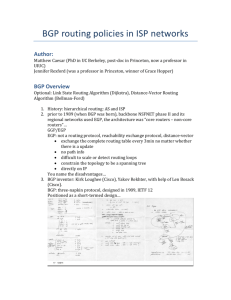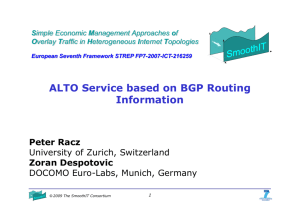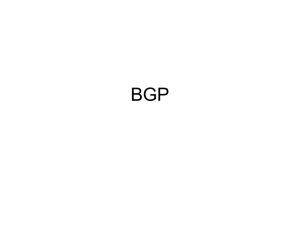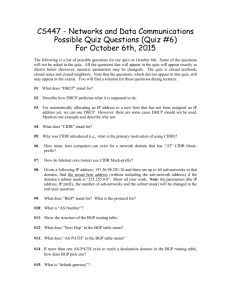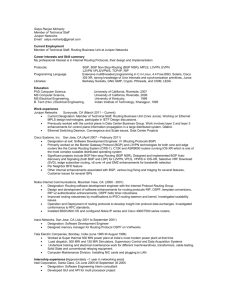ppt
advertisement
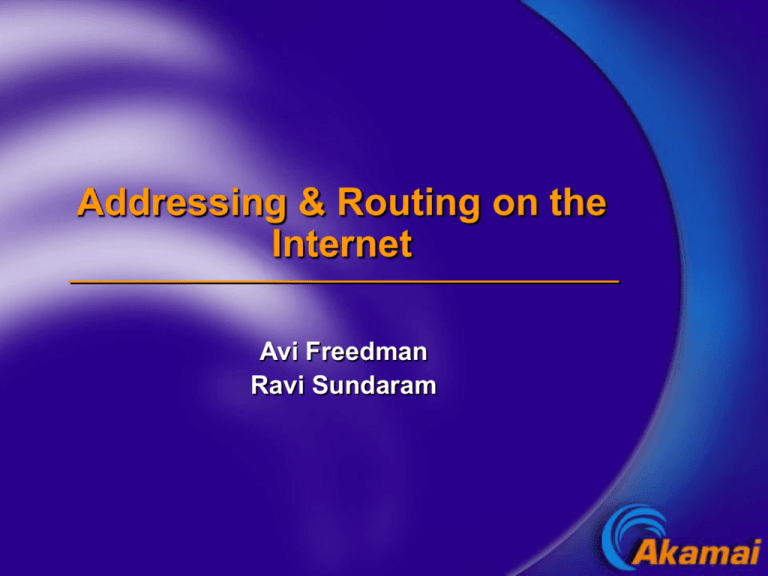
Addressing & Routing on the Internet Avi Freedman Ravi Sundaram Outline Origins of the Internet Protocols and packets Addressing – IPv4 vs IPv6 Routing - overview BGP - model BGP – convergence and hardness Introduction • The Internet is a NETWORK of networks – logically and physically • Millions of computers capable of communicating with each other in real time • Packet-based, store and forward • Addressing – way of identifying computers • Routing – getting packets from source to destination Origins • Academic experiment in 1960s, funded by ARPA – Advanced Research Projects Agency, now called DARPA • December 1969 – first 4 node network went live using 56kbps links • 1978 – IP emerges • 1982 – TCP emerges, ARPANET split into MILNET and Internet • 1983 – Internet composed of 200 computers Origins • 1984 – newsgroups emerge • 1986 – DNS emerges, motivated by email, replaces host table • 1988 – worm emerges, CERT formed • 1989 – 100,000 computers on Internet, TCP retooled to prevent congestion collapse • 1990 – commercial traffic still banned on Internet’s backbone – NSFNET • 1991 – commercial ban lifted, www emerges Origins • May 1993 – last NSFNET solicitation for private NAPs • 1995 – NSFNET replaced by vBNS – high performance backbone service linking certain universities and research centers at 155Mbps and higher, contract given to MCI (superceded by Abilene 10Gbps?) • 2002 – 350 million hosts Comments • Unprecedented growth • Decentralized control – challenges and opportunities • Performance • Reliability • Accounting • Security • Directory • End-to-end arguments in system design. ACM Trans on Comp systems, Nov 84, 277-288. Protocols FTP SMTP DNS UDP TCP ICMP IP SNMP Packets 46 to 1500 bytes Ethernet IP TCP/UDP header header header Application Data Ethernet trailer Addressing • 32 bit addresses – a.b.c.d • 4 billion potential addresses • About 250 million hosts • IPv4 based on RFC791 in 1981 Addressing • Classful in early days: Class A – first 8 bits fixed Class B – first 16 bits fixed Class C – first 24 bits fixed • CIDR – Classless Interdomain Routing a.b.c.d/m – first m bits fixed e.g. 0.0.0.0/29 = 0.0.0.0 to 0.0.0.7 • Most specific match routing rule Addressing • Issues with IPv4 Address space depletion Control by central registry No network/routing consideration No security consideration No QoS consideration Summarized as scalability, security and QoS Addressing • IPv6 or IPng 128 bits hierarchical (network-based) secure (uses IPSec) QoS (bits allocated for labeling flows) Addressing • Will migration happen 4 to 6 Scalability – CIDR/NAT (not before 2010) Secure – IPSec & application level QoS – application level Routing • Internet – collection of Autonomous Systems • Autonomous System – set of routers sharing same routing policies, routers in an AS are analogous to post offices in a country • Routing protocol – collection of rules for forwarding packets Routing • Distance(path)-vector protocols routing updates include vector of distances(paths) each node has a (policy-based)shortest path tree examples RIP, BGP4 Routing • Link-state protocols routing updates include state of links and others’ updates each node has the entire graph examples OSPF Traceroute [koods@koods-desktop ~]$ traceroute www.berkeley.edu traceroute to arachne.berkeley.edu (169.229.131.109), 30 hops max, 40 byte packets 1 172.24.80.1 (172.24.80.1) 0.401 ms 0.308 ms 0.291 ms 2 corp2-primary.kendall.akamai.com (172.24.8.2) 0.411 ms 0.334 ms 0.331 ms 3 akafire.kendall.akamai.com (172.24.44.4) 0.280 ms 0.208 ms 0.368 ms 4 65.202.32.3 (65.202.32.3) 0.608 ms 1.651 ms 0.923 ms 5 65.202.33.246 (65.202.33.246) 0.754 ms 0.664 ms 0.832 ms 6 serial4-0-2.hsipaccess1.Boston1.Level3.net (166.90.184.53) 0.912 ms 0.888 ms 0.881 ms 7 unknown.Level3.net (64.159.3.141) 1.349 ms 1.696 ms 2.018 ms 8 so-2-0-0.mp2.SanJose1.Level3.net (64.159.0.218) 85.658 ms 85.287 ms 84.278 m 9 gige9-1.hsipaccess1.SanJose1.Level3.net (64.159.2.103) 84.682 ms 84.666 ms 84.404 m 10 unknown.Level3.net (209.247.159.110) 80.145 ms 80.630 ms 80.860 m 11 ucb-gw--qsv-juniper.calren2.net (128.32.0.69) 83.634 ms 84.703 ms 110.922 m 12 vlan196.inr-201-eva.Berkeley.EDU (128.32.0.74) 83.906 ms 87.205 ms 85.161 m 13 vlan209.inr-203-eva.Berkeley.EDU (128.32.255.2) 138.753 ms 141.608 ms 142.004 m 14 arachne.Berkeley.EDU (169.229.131.109) 140.416 ms 128.705 ms 143.716 ms BGP - model • Modeled as collection of Autonomous Systems with Peering Relationships between one another. • Can be thought of as a graph G=(V,E) with Autonomous Systems represented by vertices v in V, and Peering Relationships by edges e in E. 12222 701 BGP – Border Gateway Protocol • Path-vector protocol – each vertex maintains a shortest-path tree rooted at itself • “shortest” – combo of policy and distance based metrics • Each Autonomous System selects its routes based on its own policy and the best routes of its neighbors. BGP – idealized model • The Internet is modeled as an undirected graph G=(V,E), whereV corresponds to the Autonomous Systems and E corresponds to the peering relationships. • Each vertex learns a set of route announcements from its neighbors. • A route announcement is a record with the following attributes: nlri: network layer reachability info, e.g. 1.2.3.4 as_path: ordered list of vertices starting with next hop, e.g. 701 12222 loc_pref: local preference with dlp used to denote default value BGP – idealized model • Each vertex selects the best route to a given destination. If it has many routes r_1, r_2 … r_k with the same destination, i.e. r_i.nlri = r_j.nlri, then it selects first based on highest local_pref then on shortest as_path, with ties being broken arbitrarily. • Route transformations: - Local_prefs are not communicated - No loops: v never accepts routes r where v r.as_path - The set of routes selected at v is passed onto v’s neighbors with v prepended to the as_path - Import and export policies BGP – idealized model • Import and Export Policies Export True => allow Import 17 as_path => reject • If all import and export rules are “true => allow” then BGP reduces to a pure distance vector protocol BGP – idealized model • Dynamic behavior. Informally a BGP system S = <G, Policy(G), S0>, comprising an AS graph G= (V,E), containing import and export policies for every v_j in V and initial state S0 = (c0_1,c0_2,…c)_n) where c0_j is the destination originated by v_j • If v_j is activated then it gets route announcements from its immediate neighbors and selects its best routes. BGP – question of convergence • State graph. - Directed graph of all states with S_j => S_k if there exists a v whose activation causes the change - A state S is said to be final if S => S on activation of any v. - A BGP system is said to be solvable if it has a final state - A BGP system is said to be convergent if ends up in a final state independent of the activation sequence BGP – question of convergence • Can locally well configured policies give rise to global routing anomalies? • Can the protocol diverge, i.e. cause a collection of Autonomous Systems toexchange messages forever without converging? BGP – question of convergence • Does BGP diverge in practice? There are horror stories of networks accidentally setting themselves up as sinks for all the traffic but to date no evidence of large sclae flaps. • But there are frequent and numerous occurrences of delayed convergence, as high as 50 minutes. In “Delayed Internet Routing Convergence” C. Labovitz, A. Ahuja, A. Bose & F. Jahanian, Proceedings of Sigcomm 2000, pp 175-18, they conduct experiments where they withdraw a route and replace it with another and see how long before it washes through the Internet as observed from a number of vantage points. BGP – question of convergence • In addition to various vendor specific anomalies, the main reason for long convergence is that path vector protocols consider multiple paths of a given length as opposed to distance vector protocols that consider only one path of a given length. In Labovitz et al they construct an example where every loop free path in the complete mesh is considered – given that there are an exponential number of such paths it is not surprising that convergence is delayed. BGP – question of convergence • The following example is from: Persistent route oscillations K. Varadhan, R. Govindan & D. Estrin ISI TR 96-631 BGP – question of convergence dest BAD GADGET 2 1 0 3 All rules are mod 3 Export Rules: nlri=dest => allow Import Rules: if i+1 => i then nlri=dest & as_path=[I+1,0] => loc_pref = dlp +1; nlri=d => loc_pref=dlp if i-1 => I then nlri=dest => allow BGP – question of convergence dest BAD GADGET 2 1 0 33 Does BAD GADGET have a solution? BGP – question of convergence dest BAD GADGET 2 11 0 3 Does BAD GADGET have a solution? BGP – question of convergence dest BAD GADGET 2 1 0 3 Does BAD GADGET have a solution? BGP – question of convergence dest BAD GADGET 2 1 0 33 Does BAD GADGET have a solution? BGP – question of convergence • Does BAD GADGET have a solution? - For BAD GADET to have a solution it must have a final state. - It is easy to see for single destination systems that in a final state the graph induced by the as_path at every vertex to a destination is a tree rooted at the destination, and that this final state is reachable by activating all the nodes of the tree in breadth-first order. - BAD GADGET does not have a final state and this can be checked by looking at all the (6) trees rooted at 0 and verifying that none of them work. BGP – question of convergence • The following results are from: An Analysis of BGP Convergence Properties T. Griffin & G. Wilfong Proceedings of Sigcomm 99, pp 277-288 BGP – another problem • REACHABILITY: Given a system S, vertices v and w and destination d originated by w does there exist a final state in which d is reachable from v? • REACHABILITY is in NP Pf: Guess a final state and check reachability (and finality). • To show REACHABILITY is NP-hard we demonstrate a reduction from 3-SAT. REACHABILITY is NP-hard 3-SAT example: (x1 V x2’ V x3) & (x1’ V x2’ V x3’) … x1 x2 xn w z d X1’ X2’ Xn’ C1 C2 Cm REACHABILITY is NP-hard X1=true; x2=false; x3=false… x1 x2 xn w z d X1’ X2’ Xn’ C1 C2 Cm REACHABILITY is NP-hard • Export policies: true => allow. • Import policies: enforce that only one of xj or xj’ is in the as_path of a route to d and oncethe route is chosen then a lock-in is forced. Example xj xj’: nlri=d => loc_pref = dlp + 1; xj-1 xj : nlri=d & xj-1’ not in as_path => loc_pref = dlp; For clause Cj = xk V xl V xm: xk in as_path or xl in as_path or xm in as_path => loc_pref = dlp. REACHABILITY is NP-hard • Satisfiable => REACHABLE Pf: activate along the literals that are set to true. • REACHABLE => satisfiable Pf: Follows trivially from the way the policies work to ensure a unique path. Other Problems and Implications • ASYMMETRY • SOLVABILITY • ROBUSTNESS • RADB and centralized vetting Research Consider a path vector protocol such as BGP – at each step a node gets information from its neighbors and uses its (local) policy to update its table of routes. A topology and collection of policies is satisfiable if there exists a state where updates do no changes. A system is said to converge if it reaches such a state. The problem is to try and characterize the behavior of these systems – when do they diverge, can they converge to more than one satisfiable state. Reference: www.acm.org/pubs/citations/proceedings/comm/3 16188/p277-griffin/ Questions?

